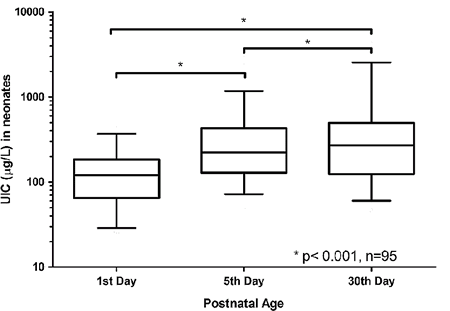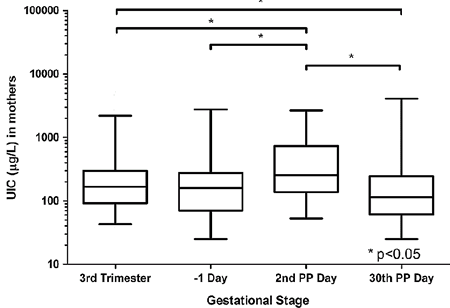ICEECE2012 Poster Presentations Thyroid (non-cancer) (188 abstracts)
Maternal-neonatal relationship of iodine metabolism in perinatal period: Changes in urinary iodine excretion in Japanese mothers and newborn infants
Y. Fuse 1 , H. Ogawa 2 , M. Fujita 2 , N. Arata 3 , S. Harada 1 , T. Ohashi 4 , Y. Shishiba 5 & M. Irie 5
1National Research Institute for Child Health and Development, Tokyo, Japan; 2Ogawa Clinic, Yokohama, Japan; 3National Medical Center for Children and Mothers, Tokyo, Japan; 4Institute of Microchemical Technology, Kawasaki, Japan; 5Foundation for Growth Science, Tokyo, Japan.
In the perinatal period iodine deficiency results in growth and mental impairment in fetus and newborns. However, there are limited data on iodine metabolism in mother and infants during this critical period.
Objective: To assess the changes in urinary iodine concentration (UIC) in mothers and neonates.
Methods: From July 2010 to October 2011, 155 pregnant women(31.1±2.1 years) without thyroid disease and their term infants (38.7±4.7 weeks) were consecutively studied. The spot urine and blood samples were collected in the third trimester of pregnancy and one day before birth, the 2nd and 30th postpartum day. Neonatal urine was collected using a small self-adhesive sterile bag in the first, 5th and 30th postnatal day. The subjects with thyroid antibodies or serum TSH and FT4 values out of the reference interval were excluded.
Results:
i) In neonates (n=95), median UIC was 121.0 μg/L in the first voided urine, then increased to 223.0 μg/L in the 5th day and reached to 271.0 μg/L in the 30th day.
ii) Maternal median UIC was 166.5 μg/L in the third trimester and not significantly different from that in one day before birth (158.5 μg/L). At the 2nd postpartum day urinary iodine excretion abruptly increased to 256.0 μg/L, then decreased to 115.0 μg/L at the 30th postpartum day(n=150).
iii) The maternal UIC in one day before birth was well correlated with that of their neonates at birth (Spearman r=0.214, n=126).
iv) At one month the median UIC of the formula-fed infants was 108.0 μg/L and significantly lower than that of breast-fed infants (246.0 μg/L).
Conclusion: In Japan, an iodine-sufficient area, newborn infants have sufficient iodine store atd excrete as much iodine as adults’ level after 5th postnatal day. Major iodine source is breast milk and the iodine store might be not depleted at least one month after birth.
pp: post partum
Declaration of interest: The authors declare that there is no conflict of interest that could be perceived as prejudicing the impartiality of the research project.
Funding: This work was supported, however funding details unavailable.



 }
}



